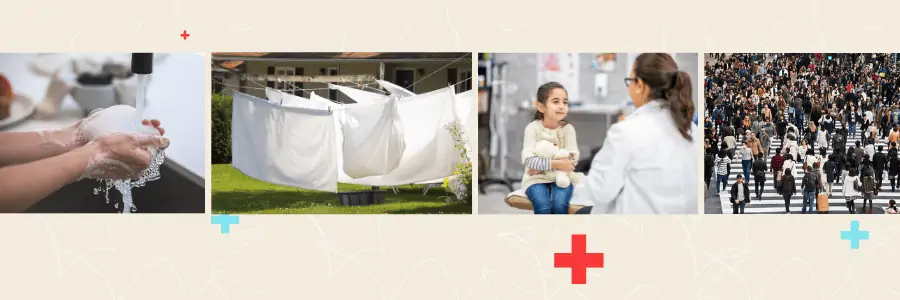Respiratory Syncytial Virus (RSV): 6 Important Things You Should Know

- What is Respiratory Syncytial Virus (RSV)?
- What are the symptoms of RSV?
- What are the causes of RSV?
- Who is at risk?
- How is RSV diagnosed?
- Common RSV Treatments
- What can I do to prevent my child from getting infected by RSV?
- References
What is Respiratory Syncytial Virus (RSV)?
Respiratory Syncytial Virus also known as RSV is a common respiratory virus that causes cold-like symptoms. It is also noted that RSV is very contagious and infects the respiratory system of children. RSV is so common that most children have been infected with the virus by the age of 2. Adults may also get infected by the virus but they can recover faster due to very mild symptoms.
It is a known fact that for some children and infants this disease can be life-threatening as it sends more babies to the hospital compared to many other diseases.
Continue reading to gain more information all about Respiratory Syncytial Virus.
What are the symptoms of RSV?
The signs of RSV at the early stages are very similar to mild cold symptoms that consist of runny nose, fever, cough, and also sore throat. It should be taken note that young infants might express themselves as irritable, fatigued, and also experiencing difficulties in breathing. On the positive side, all these symptoms would ideally clear up on their own in a few days.

The alarming signs of a more serious illness would be barking or wheezing cough whereby parents should show extra concern. At this particular point, it is believed that this virus has spread down to the lower respiratory tract and causes all the small airways entering the lungs to be inflamed. Unfortunately, this might increase the risk of pneumonia or bronchitis.
Severe stages of respiratory syncytial virus in infants would result in short, shallow, and rapid breathing. Infants won’t be able to verbally express their symptoms. However, parents would be able to identify this by a few physical changes in their infant’s body. For instance, the most common thing that can be identified is the “caving-in” of the chest which includes in between and under the ribs (chest wall retractions). The second most prominent thing that can be identified is the “spreading-out” of the nostril after every breath (nasal flaring) and also accompanied by fast breathing that’s abnormal. If you notice the infant’s mouth, lips, and fingernails turning blue then it’s due to a lack of oxygen in their body.
What are the causes of RSV?

So, you may be wondering what is the exact cause of getting infected with RSV. Respiratory Syncytial Virus is commonly spread from one person to another due to close contact with someone that’s infected by RSV.
To be more specific & detailed, Respiratory Syncytial Virus can spread by:
- An infected person coughs or sneezes.
- Virus droplets from a cough or sneeze in your eyes, nose, or mouth.
- Touch a surface that has the virus on it, like a pen, and then touch your face before washing your hands.
- Direct contact with the virus, like kissing the face of a child with RSV.
Usually, it takes from two to eight days from the time of exposure for someone to get sick due to the infection. This disease usually lasts from three to seven days and they are the most contagious at this specific time. But among infants, the virus may continue to spread even after symptoms go away, for up to four weeks.
Who is at risk?
Respiratory Syncytial Virus can be alarming for several infants and young children. RSV is known as one of the most prevalent respiratory diseases in Malaysia. It is noted that those who are at greater risk are:
- Premature infants
- Very young infants, especially those 6 months and younger
- Children younger than 2 years old with chronic lung disease or congenital (present from birth) heart disease
- Children with weakened immune systems
- Children who have neuromuscular disorders, including those who have difficulty swallowing or clearing mucus secretions

How is RSV diagnosed?
It is ideal to bring your child to see a doctor when symptoms such as difficulty breathing, a high fever, or the skin turning pale & blue, particularly on the lips and in the nail beds.
As symptoms of respiratory syncytial virus are closely related to the symptoms of the common cold, doctors may suspect respiratory syncytial virus based on your child’s medical history and physical examination. Oftentimes, lab tests will be conducted to confirm the diagnosis. Mouth swabs and blood tests to check white blood cell counts and detect the presence of viruses are particularly common.
On rare occasions, severe Respiratory Syncytial Virus cases among children or infants might require extra attention and surveillance therefore, they must be hospitalised. This is to make sure imaging tests known as chest X-rays or CT scans will be conducted to monitor the condition of the lung and the complications accompanied by RSV. Other than that, blood and urine cultures may be needed if the infants are very sick due to the possibility of Respiratory Syncytial Virus-related bronchiolitis that can occur together with a urinary tract infection among newborns.

Common RSV Treatments
It is also useful for parents to equip themselves with the knowledge of treating respiratory syncytial virus symptoms among their children at home. Therefore, caring for a baby with respiratory syncytial virus infection involves treating the symptoms and how it affects your baby’s respiratory system.
Most babies and young children can be taken care of at home:
- Remove sticky nasal fluids with a nasal aspirator or saline drops.
- Use a mist vaporiser to keep the air moist and make breathing easier.
- Replenish them by giving fluids in small amounts throughout the day.

What can I do to prevent my child from getting infected by RSV?
No vaccines are available for the respiratory syncytial virus. However, parents of children at high risk for developing severe Respiratory Syncytial Virus disease should help their child by engaging in these few ways:
- Avoid close contact– Close contact with adults or children with cold symptoms might increase the likelihood to get infected with RSV. Therefore, protect your kids from sick adults by not encouraging them to carry or kiss the child.
- Wash their hands often– It is advised to wash their hands with soap and water for at least 20 seconds before touching their face. Remind them to wash their hands before eating or after the bathroom and also touch random objects in various places.
- Protect them from highly contagious settings-Limit the time they spend in child-care centers or other settings. This may help prevent infection and the spread of the virus during the RSV season.
- Check with your doctor–Understand & discuss the risk factor of your child with your paediatrician.
- Ensure their surroundings clean and sanitised–Keep their toys, blankets, sheets & belongings clean.

Thank you for reading our article on Respiratory Syncytial Virus! If you have any further questions, feel free to contact us or drop by our clinic.
References
Rahman MM, Wong KK, Hanafiah A, Isahak I. Influenza and respiratory syncytial viral infections in Malaysia: Demographic and clinical perspective. Pak J Med Sci 2014;30(1):161-165. doi: http://dx.doi.org/10.12669/pjms.301.4272
Dunkin, M. A. (n.d.). RSV: Symptoms, causes, prevention, treatments. WebMD. https://https://www.webmd.com/lung/rsv-in-babies
Kliegman RM, et al. Respiratory syncytial virus. In: Nelson Textbook of Pediatrics. Elsevier; 2020. https://www.clinicalkey.com.
Respiratory syncytial virus infection (RSV): Symptoms and care. Centers for Disease Control and Prevention. https://www.cdc.gov/rsv/about/symptoms.html.
Respiratory syncytial virus infection (RSV): RSV in infants and young children. Centers for Disease Control and Prevention. https://www.cdc.gov/rsv/high-risk/infants-young-children.html.
